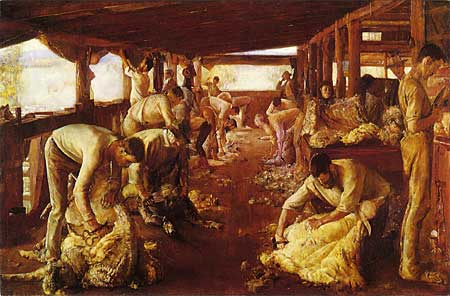Folk songs are often a reflection of people, cultures, past times and events, poems and narratives set to music and passed down from generation to generation.
Australian folk songs often relate to sheep and shearing, nit surprising since the development of the colony and the subsequent rural growth owed much to the wool industry, particularly merinos, and the export of wool overseas. It came to be summed up in the expression that Australia rodae on the sheep’s back. What cattle and cowboys are to the Americans and their folk history, sheep and shearers are to Australia.
Now that spring is upon us, it is appropriate to have a closer look at a folk song entitled “The Springtime it Brings on the Shearing”.
____________________
See and hear:
Hear the Botany Bay Singers perform the song by clicking on the following link:
____________________
Lyrics:
There are longer versions, here is a shorter one:
The Springtime It Brings on the Shearing
Oh the springtime it brings on the shearing
And its then you will see them in droves,
To the west country stations all steering
A seeking a job off the coves.
Chorus
With a ragged old swag on my shoulder,
And a billy quart-pot in my hand
I’ll tell you we’ll astonish the new chums
When they see how we travel the land.
From Billabone, Murray and Loddon
To the far Tatiara and back,
The hills and the plains are well trodden
By the men on the wallaby track
Chorus
And after the shearing’s all over
And the wool season’s all at an end,
It’s then you will see the flash shearers
Making Johnny-cakes round in the bend.
Chorus
____________________
Some notes:
The song was originally a poem, ‘On the Wallaby Track” written by E. J. Overbury, published in 1865. It is unknown who turned the poem into a song. It is believed that the song already existed in the 19th century.
Danny Spooner sang Springtime It Brings On the Shearing in 2004 on his album of Australian songs of toil and reward, 'Ard Tack. He noted:
“After pastoralists climbed up over the barrier of the Blue Mountains in 1815, there was no stopping the land-hungry. There were laws limiting their expansion, but no way of policing them. As their animals reduced the pasture (which had been created by aboriginal fire-farming) they simply moved on to the next area. There was little or no attempt made to care for or improve the land. The itinerant shearers and labourers followed seeking work and had to know well the country.”
___________________
Glossary of words and phrases:
stations:
sheep stations
coves:
station owners and station managers
swag:
a bed roll or bag that bundled the belongings of travellers, such as itinerant workers and shearers travelling from station to station looking for work.
billy quart pot:
A billycan, often shortened to billy, is a lightweight cooking pot in the form of a metal can commonly used for boiling water, making tea or cooking over a campfire. The name is believed to derive from the Scots billy-pot, meaning a cooking utensil. See the photo above and:
new chums:
newly arrived immigrants
Billabone, Murray and Loddon:
these were sheep stations in north-western Victoria.
Tatiara:
a district on the Victorian-South Australian border
wallaby track:
the route from station to station of people looking for work
flash shearers making johnny-cakes round in the bend:
From Edgar Waters at: https://garyshearston.com/html/springtime_notes1.html
a contrast in the lot of the shearer at different seasons of the year is implied; during the shearing season he is flash (shows an exaggerated sense of his own importance), because he is earning good wages and respect for his skill; when the shearing season is over, and he is unemployed, he is reduced to camping out in the open by some river bend, and living on a diet consisting mainly of camp-made bread (a johnny cake is, roughly speaking, a kind of small damper).
____________________
Some shearing pics:
There is no doubt that shearing was hard, backbreaking work. The following is from Wikipedia:
During the early years of sheep breeding in Australia, shearing was carried out by shepherds, assigned servants, Ticket of Leave men, and free labourers using blade shears. As the sheep industry expanded, more shearers were required. Although the demand had increased, the conditions had not, and shearers had to contend with terrible working conditions, very long hours and low pay. In 1888, Australia became the first country in the world have a complete shearing, at Dunlop Station, finished using machines. By 1915, most large Australian sheep station shearing sheds had machines that were powered by steam engines. Later, internal combustion engines powered machines until rural power supplies became available.
Shearing in the Riverina, 1923
Sydney sheep sales, 1953
1890








No comments:
Post a Comment
Note: Only a member of this blog may post a comment.